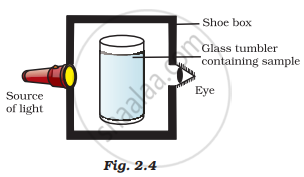Advertisements
Advertisements
Question
Give an example of a solid in a liquid.
Solution
Solid in liquid – NaCl in water
APPEARS IN
RELATED QUESTIONS
Write the steps you would use for making tea. Use the words: solution, solvent, solute, dissolve, soluble, insoluble, filtrate and residue.
Pragya tested the solubility of three different substances at different temperatures and collected the data as given below (results are given in the following table, as grams of substance dissolved in 100 grams of water to form a saturated solution).
| Substance dissolved | Temperature in K | ||||
| 283 | 293 | 313 | 333 | 353 | |
| Solubility | |||||
| Potassium nitrate | 21 | 32 | 62 | 106 | 167 |
| Sodium chloride | 36 | 36 | 36 | 37 | 37 |
| Potassium chloride | 35 | 35 | 40 | 46 | 54 |
| Ammonium chloride | 24 | 37 | 41 | 55 | 66 |
- What mass of potassium nitrate would be needed to produce a saturated solution of potassium nitrate in 50 grams of water at 313 K?
- Pragya makes a saturated solution of potassium chloride in water at 353 K and leaves the solution to cool at room temperature. What would she observe as the solution cools? Explain.
- Find the solubility of each salt at 293 K. What salt has the highest solubility at this temperature?
- What is the effect of change of temperature on the solubility of a salt?
Identify the solutions among the following mixtures.
- Soil
- Sea water
- Air
- Coal
- Soda water
Explain the following giving an example.
Suspension
The number of components in a binary solution is ______
The component present in a lesser amount, in a solution, is called ______
Define the term: Solution
Give an example of solid in solid.
Give an example of gas in gas.
The teacher instructed three students ‘A’, ‘B’ and ‘C’ respectively to prepare a 50% (mass by volume) solution of sodium hydroxide (NaOH). ‘A’ dissolved 50g of NaOH in 100 mL of water, ‘B’ dissolved 50g of NaOH in 100g of water while ‘C’ dissolved 50g of NaOH in water to make 100 mL of solution. Which one of them has made the desired solution and why?
Name the process associated with the following
A potassium permanganate crystal is in a beaker and water is poured into the beaker with stirring.
A solution is always a liquid. Comment.
A group of students took an old shoebox and covered it with black paper from all sides. They fixed a source of light (a torch) at one end of the box by making a hole in it and making another hole on the other side to view the light. They placed a milk sample contained in a beaker/tumbler in the box as shown in Fig.2.4. They were amazed to see that milk taken in the tumbler was illuminated. They tried the same activity by taking a salt solution but found that light simply passed through it?
(a) Explain why the milk sample was illuminated. Name the phenomenon involved.
(b) The same results were not observed with a salt solution. Explain.
(c) Can you suggest two more solutions that would show the same effect as shown by the milk solution?

Arun has prepared a 0.01% (by mass) solution of sodium chloride in water. Which of the following correctly represents the composition of the solutions?
When the solid (Solute) dissolves in a liquid (Solvent), it becomes a solution.
What is a solute?
What is the solvent?
